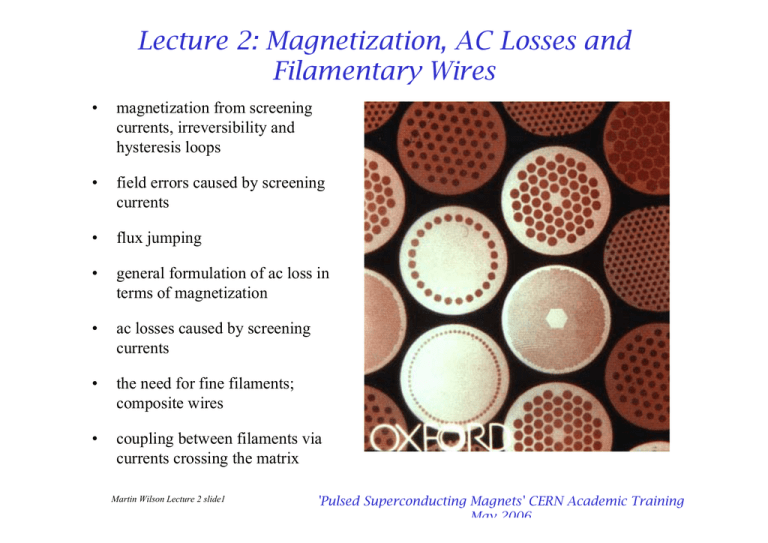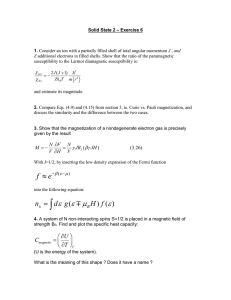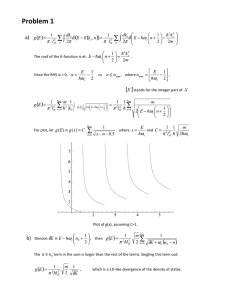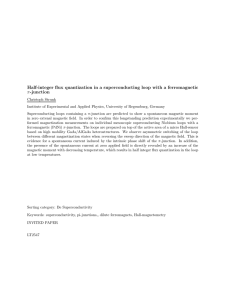Lecture 2: Magnetization, AC Losses and Filamentary Wires
advertisement

Lecture 2: Magnetization, AC Losses and Filamentary Wires • magnetization from screening currents, irreversibility and hysteresis loops • field errors caused by screening currents • flux jumping • general formulation of ac loss in terms of magnetization • ac losses caused by screening currents • the need for fine filaments; composite wires • coupling between filaments via currents crossing the matrix Martin Wilson Lecture 2 slide1 'Pulsed Superconducting Magnets' CERN Academic Training May 2006 Recap the flux penetration process plot field profile across the slab B fully penetrated field increasing from zero field decreasing through zero Martin Wilson Lecture 2 slide2 'Pulsed Superconducting Magnets' CERN Academic Training May 2006 Magnetization of the Superconductor When viewed from outside the sample, the persistent currents produce a magnetic moment. As for any magnetic material, we can define a magnetization of the superconductor (magnetic moment per unit volume) I I .A M =∑ V V where distributed currents flow, we must integrate over the bulk of the material A NB: M is units of H For a fully penetrated superconducting slab by symmetry integrate half width J a J .a 1 M = ∫ J c .x.dx = c a0 2 B J B x x Martin Wilson Lecture 2 slide3 Note: Jc varies with field, so does M 'Pulsed Superconducting Magnets' CERN Academic Training May 2006 Magnetization of a Superconducting wire for cylindrical filaments the inner current boundary of screening current penetration is roughly elliptical (controversial) J J J B when fully penetrated, the magnetization is more commonly M= 2 3π Jc d f M= 4 3π Jc a (compare M = 1 J c a for the slab) 2 where a and df = filament radius and diameter Recap: M is defined per unit volume of NbTi filament Martin Wilson Lecture 2 slide4 'Pulsed Superconducting Magnets' CERN Academic Training May 2006 Measurement of magnetization In field, the superconductor behaves just like a magnetic material. We can plot the magnetization curve using a magnetometer. It shows hysteresis - just like iron only in this case the magnetization is both diamagnetic and paramagnetic. M B Note the minor loops, where field and therefore screening currents are reversing The magnetometer, comprising 2 balanced search coils, is placed within the bore of a superconducting solenoid. These coils are connected in series opposition and the angle of small balancing coil is adjusted such that, with nothing in the coils, there is no signal at the integrator. With a superconducting sample in one coil, the integrator measures magnetization when the solenoid field is swept up and down Martin Wilson Lecture 2 slide5 'Pulsed Superconducting Magnets' CERN Academic Training May 2006 Magnetization of NbTi The induced currents produce a magnetic moment and hence a magnetization = magnetic moment per unit volume M Bext Martin Wilson Lecture 2 slide6 'Pulsed Superconducting Magnets' CERN Academic Training May 2006 Reversible magnetization irreversible magnetization •We have been discussing the irreversible magnetization, produced by bulk currents and thus by flux pinning. •In addition, there is another component - the reversible (non hysteretic) magnetization. It is shown by all type 2 superconductors even if they have no flux pinning. In technical (strong pinning) materials however it is negligible in comparison with the irreversible component Martin Wilson Lecture 2 slide7 reversible magnetization 'Pulsed Superconducting Magnets' CERN Academic Training May 2006 Very fine filaments fine filament thick filament At zero external field, magnetization currents ensure that there is still a field inside the filament. Magnetization is smaller with fine filaments, so the average field within the filament is smaller. For this reason, the Jc at zero field measured on fine filament is greater than thick filaments. Martin Wilson Lecture 2 slide8 'Pulsed Superconducting Magnets' CERN Academic Training May 2006 HTS magnetization Magnetization is shown by all superconducting materials. Here we see the magnetization of a high temperature superconductor. The glitches in the lower curve are flux jumps - see lecture 8 Martin Wilson Lecture 2 slide9 'Pulsed Superconducting Magnets' CERN Academic Training May 2006 Magnetization in superconductor ⇒ field error in magnet 0 .E +0 0 sextupole (T) -1 .E -0 4 -2 .E -0 4 -3 .E -0 4 0 1 2 fie ld (T) 3 4 sextupole field in the GSI FAIR prototype dipole D001 without the iron yoke, dc field in Tesla at radius 25mm measured at BNL by Animesh Jain Martin Wilson Lecture 2 slide10 'Pulsed Superconducting Magnets' CERN Academic Training May 2006 Synchrotron injection don't inject here! • synchrotron injects at low field, ramps to high field and then back down again M • magnetization error is worst at injection because M is largest and B is smallest, so μoM/B is largest . B much better here! Martin Wilson Lecture 2 slide11 • note how quickly the magnetization changes when we start the ramp up • so better to ramp up a little way, then stop to inject 'Pulsed Superconducting Magnets' CERN Academic Training May 2006 Flux penetration from another viewpoint Think of the screening currents, in terms of a gradient in fluxoid density within the superconductor. Pressure from the increasing external field pushes the fluxoids against the pinning force, and causes them to penetrate, with a characteristic gradient in fluxoid density At a certain level of field, the gradient of fluxoid density becomes unstable and collapses – a flux jump superconductor Martin Wilson Lecture 2 slide12 vacuum 'Pulsed Superconducting Magnets' CERN Academic Training May 2006 Flux jumping: why it happens Unstable behaviour is shown by all type 2 and HT superconductors when subjected to a magnetic field It arises because:magnetic field induces screening currents, flowing at critical density Jc B * reduction in screening currents allows flux to move into the superconductor B flux motion dissipates energy thermal diffusivity in superconductors is low, so energy dissipation causes local temperature rise ΔQ critical current density falls with increasing temperature Δθ Δφ go to * Cure flux jumping by making superconductor in the form of fine filaments – weakens ΔJc ⇒ Δφ ⇒ ΔQ Jc Martin Wilson Lecture 2 slide13 'Pulsed Superconducting Magnets' CERN Academic Training May 2006 Flux jumping: the numbers for NbTi criterion for stability against flux jumping a = half width of filament 1 a≤ Jc 1 ⎫2 ⎧ 3 γ C (θ c − θ o ) ⎨ ⎬ μo ⎩ ⎭ typical figures for NbTi at 4.2K and 1T Jc critical current density = 7.5 x 10 9 Am-2 γ density = 6.2 x 10 3 kg.m3 C specific heat = 0.89 J.kg-1K-1 θ c critical temperature = 9.0K so a = 33μm, ie 66μm diameter filaments Notes: • least stable at low field because Jc is highest • instability gets worse with decreasing temperature because Jc increases and C decreases • criterion gives the size at which filament is just stable against infinitely small disturbances - still sensitive to moderate disturbances, eg mechanical movement • better to go somewhat smaller than the limiting size • in practice 50μm diameter seems to work OK Flux jumping is a solved problem9 Martin Wilson Lecture 2 slide14 'Pulsed Superconducting Magnets' CERN Academic Training May 2006 Magnetization and Losses: General I1 in general, the change in magnetic field energy δE = HδB (see textbooks on electromagnetism) i2 a2 M work done by battery to raise current in solenoid H so work done on magnetic material W = ∫ μo HdM around a closed loop, energy dissipated in material E = ∫ μo HdM = ∫ μo MdH Martin Wilson Lecture 2 slide15 W = ∫ V1I1dt = ∫ I1L11 dI1 di dt − ∫ I1L21 2 dt dt dt 1 2 = L11I12 − ∫ I1L21di2 first term is change in stored energy of solenoid I1L21 is the flux change produced in loop 2 ∫ I1L21di2 = ∫ μ oH 1a2 di2 = ∫ μ oH 1dM so battery work done on loop = ∫ μ o H 1 d M 'Pulsed Superconducting Magnets' CERN Academic Training May 2006 Hysteresis Losses M With the approximation of vertical lines at the 'turn around points' and saturation magnetization in between, the hysteresis loss per cycle is H E = ∫ μo MdH ≅ ∫ MdB W = ∫ μo HdM = ∫ μ o MdH This is the work done on the sample Strictly speaking, we can only say it is a heat dissipation if we integrate round a loop and come back to the same place - otherwise the energy just might be stored Around a loop the red 'crossover' sections are complicated, but we usually approximate them as straight vertical lines (dashed) Martin Wilson Lecture 2 slide16 In the (usual) situation where dH>>M, we may write the loss between two fields B1 and B2 as B2 E≅ ∫ MdB B1 & = 2 J d B& P M B = c f so the loss power is 3π losses in Joules per m3 and Watts per m3 of superconductor 'Pulsed Superconducting Magnets' CERN Academic Training May 2006 Variable current density in superconductor M B To evaluate need Jc(B) Kim Anderson approximation J c ( B) = B2 E≅ 2 2 J o Bo E= d f dB 3π B∫ ( B + Bo ) ∫ MdB B1 B2 E= ∫ B1 Martin Wilson Lecture 2 slide17 1 M= recap loss for ramp up from B1 to B2 B B2 B1 J o Bo ( B + Bo ) 2 3π 2 3π Jc d f J c d f .dB E= ⎧ B + Bo ⎫ 2 d f J o Bo ln ⎨ 2 ⎬ 3π ⎩ B1 + Bo ⎭ loss in Joules per m3 of superconductor 'Pulsed Superconducting Magnets' CERN Academic Training May 2006 The effect of transport current • in magnets there is a transport current, coming from the power supply, in addition to magnetization currents. • because the transport current 'uses up' some of the available Jc the magnetization is reduced. • but the loss is increased because the power supply does work and this adds to the work done by external field total loss is increased by factor (1+i2) E= B ⎧ B + Bo ⎫ 2 2 d f J o Bo ln ⎨ 2 ⎬(1 + i ) 3π ⎩ B1 + Bo ⎭ usually not such a big factor because • design for a margin in Jc plot field profile across the slab where i = Imax / Ic Jc • most of magnet is in a field much lower than the peak B Martin Wilson Lecture 2 slide18 'Pulsed Superconducting Magnets' CERN Academic Training May 2006 The need for fine filaments M= Magnetization 2 3π Jc d f • d as small as possible, typically 7μm • critical current of a 7μm filament in 5T at 4.2K = 0.1A Flux Jumping a≤ 1 ⎫2 1 ⎧ 3 γ C (θ c − θ o ) ⎨ ⎬ Jc ⎩ μo ⎭ • for NbTi d < 50μm • critical current of a 50μm filament in 5T at 4.2K = 0.1A AC Losses E = 4 d f J o Bo ln ⎧⎨ B2 + Bo ⎫⎬ 3π ⎩ B1 + Bo ⎭ • df as small as possible, typically 7μm, for FAIR we are thinking of 3μm • critical current of a 7μm filament in 5T at 4.2K Ic = 0.1A; for a 3μm filament Ic = 0.02A Martin Wilson Lecture 2 slide19 so we need multi-filamentary wires 'Pulsed Superconducting Magnets' CERN Academic Training May 2006 Fine filaments recap M= 2 Jc d f 3π We can reduce M by making the superconductor as fine filaments. For ease of handling, an array of many filaments is embedded in a copper matrix Unfortunately, in changing fields, the filament are coupled together; screening currents go up the LHS filaments and return down the RHS filaments, crossing the copper at each end. In time these currents decay, but for wires ~ 100m long, the decay time is years! So the advantages of subdivision are lost Martin Wilson Lecture 2 slide20 'Pulsed Superconducting Magnets' CERN Academic Training May 2006 Twisting 1 • coupling may be reduced by twisting the wire B` • coupling currents now flow along the filaments and cross over the resistive matrix every ½ twist pitch Q Y • now the matrix crossing currents flow vertically, parallel to the changing field θ P S • at each end of the wire, the current crosses over horizontally and then returns along the other side of the wire R • we assume the filaments have not reached Jc and so there is no electric field along them • thus the electric field due to flux change linked by the filament lies entirely on the vertical path Y • thus we have a uniform electric field in the matrix Martin Wilson Lecture 2 slide21 Q R ∫ ∫ E dl = Bi′ a cosθ dz = Q Ey = P Bi′ P 2π 2 Bi′ p Y 2π where p is the twist pitch 'Pulsed Superconducting Magnets' CERN Academic Training May 2006 Twisting 2 • a uniform electric field across the resistive matrix implies a uniform vertical current density Jy gz • a consideration of how this current enters and leaves the outer ring of filaments shows that there must be a linear current density gz (A/m) along the wire where Jy θ 2 B′ ⎧ p ⎫ g z (θ ) = g zo cos θ = i ⎨ ⎬ cos θ ρt ⎩ 2π ⎭ where ρt is the transverse resistivity across the matrix and p is the twist pitch. • note that, because of twist, g reverses on left hand side • recap from theory of fields in magnets that a Cosθ current distribution around a cylinder produces a perfect dipole field inside • so Ohm's law has given us the exact field needed to screen the external changing field and the internal field Bi is less than the external field Be Martin Wilson Lecture 2 slide22 Bdip = μo 2 g zo μ o Bi′ ⎛ p ⎞ 2 Bi = Be − g z (0) = Be − ⎜ ⎟ 2 2 ρ t ⎝ 2π ⎠ μo 'Pulsed Superconducting Magnets' CERN Academic Training May 2006 Twisting 3 we may define a time constant (compare with eddy currents) μo ⎛ p ⎞2 τ= ⎜ ⎟ 2 ρ t ⎝ 2π ⎠ so that Bi = Be − Bi′ τ and integrate the magnetic moment of the screening currents to calculate a coupling component of magnetization π M= 2 4 πa 2 M= ∫ g z (θ ) a cosθ a dθ 0 2 μo provided the external field has changed by more than Mcp we may take B`i ~ B`e Bi′ τ Note that the coupling magnetization is defined over the volume enclosed by the filament boundary. To define over the wire volume must multiply by a filling factor λ fb = d 2fb d w2 Martin Wilson Lecture 2 slide23 M c= 2 μo dw dfb λ fb Bi′ τ 'Pulsed Superconducting Magnets' CERN Academic Training May 2006 Twisting 4 Summing the persistent current and coupling current components, we get the total magnetization of the wire. M To define over the wire volume, we need a fill factor for the NbTi filaments λf = volume NbTi volume wire so the total wire magnetization M w = λ f M p + λ fb M c 2 2 M w= λ f J c ( B) d f + λ fb Bi′ τ 3π μo Martin Wilson Lecture 2 slide24 B 'Pulsed Superconducting Magnets' CERN Academic Training May 2006 Poor contact to filaments J ρt = ρCu 1+ λ 1− λ Thick copper jacket include the copper jacket as a resistance in parallel Martin Wilson Lecture 2 slide25 Transverse resistivity Good contact to filaments Jy where λ is the fraction of superconductor (after J Carr) J ρt = ρCu 1− λ 1+ λ Some complications Copper core resistance in series for part of current path 'Pulsed Superconducting Magnets' CERN Academic Training May 2006 • measure magnetization loops at different ramp rates B` • plot M versus B` at chosen fields • calculate ρt as a function of B - note the magnetoresistance 10000 M (A/m) Measurement of ρt 5000 B = 0.5 T B = 0.1T B = 0.7T 0 0.00 B = 0T B = 0.2T 0.10 B = 0.05T B = 0.3T 0.20 B` (T/s) et.( .m) 1.E-09 5.E-10 0.E+00 0 Martin Wilson Lecture 2 slide26 1 2 B (T) 3 4 'Pulsed Superconducting Magnets' CERN Academic Training May 2006 Coupling magnetization and field errors Coupling magnetization gives a field error which adds to persistent current magnetization and is proportional to ramp rate. skew quadrupole error 300 6 mT/sec 13 mT/seec 19 mT/sec 200 skew quadrupole error in Nb3Sn dipole which has exceptionally large coupling magnetization (University of Twente) 100 0 -100 -200 -300 0 1 Martin Wilson Lecture 2 slide27 2 Field B (T) 3 4 5 'Pulsed Superconducting Magnets' CERN Academic Training May 2006 Magnetization, ac losses and filamentary wires: concluding remarks • magnetic fields induce persistent screening currents in superconductor - which make it look like a magnetic material with a magnetization M • for the technological type 2 superconductors, the magnetization is irreversible and hysteretic, ie it depends on the history • magnetization ⇒ field errors in the magnet - usually the greatest source of error at injection • magnetization can go unstable ⇒ flux jumping ⇒ quenches magnet - avoid by fine filaments - solved problem • ac losses may be calculated from the area of the magnetization hysteresis loop (remember this is only the work done by the external field, transport current loss is extra) • magnetization is proportional to filament diameter, so can reduce these problems by making fine filaments - typically 50μm for flux jumping and 5 - 10μm for losses and field quality • practical conductors are made in the form of composite wires with superconducting filaments embedded in a matrix of copper • in changing fields the filaments are coupled together through the matrix, thereby losing the benefit of subdivision • twisting the composite wire reduces coupling • coupling time constant depends on twist pitch and effective transverse resistivity, which is a function of contact resistance and geometry Martin Wilson Lecture 2 slide28 'Pulsed Superconducting Magnets' CERN Academic Training May 2006





